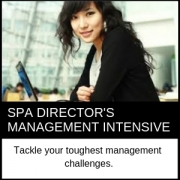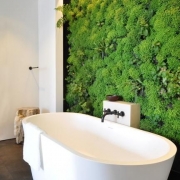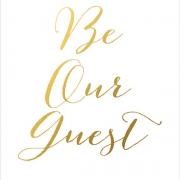Posts
Spa Director’s Management Intensive 2011
/3 Comments/in Education, Featured, Seminars /by lstarr@wynnebusiness.com
If you own, manage, or plan to open or acquire a spa, this program is a must!
Presented by Lisa M. Starr and Peggy Wynne Borgman of Wynne Business Spa Consulting
 If you’re already involved in spa operations, you’ll find solutions for your toughest management challenges. If you’re planning a facility, you’ll leave this program with a clear-cut strategy for business success. If you’re considering a career change or advancement into spa management, the Spa Director’s Management Program will put you miles ahead of the competition. This fast-paced, information-packed program is full of original, innovative but practical concepts that are actually at work in top spas. We work hard to make sure the days you spend with us are extremely rewarding. You’ll also take home our exclusive text, an incredible reference you’ll use again and again. This includes tools you’ll be able to put to use the day you return to work. You’ll have a chance to meet other spa industry professionals, a diverse group of people, from all over the world. Participants typically represent a variety of industries and greatly enrich the program with their input. You’ll create a support network that will prove invaluable as your business or career grows. The small size of the class ensures individual attention and maximum interaction.
If you’re already involved in spa operations, you’ll find solutions for your toughest management challenges. If you’re planning a facility, you’ll leave this program with a clear-cut strategy for business success. If you’re considering a career change or advancement into spa management, the Spa Director’s Management Program will put you miles ahead of the competition. This fast-paced, information-packed program is full of original, innovative but practical concepts that are actually at work in top spas. We work hard to make sure the days you spend with us are extremely rewarding. You’ll also take home our exclusive text, an incredible reference you’ll use again and again. This includes tools you’ll be able to put to use the day you return to work. You’ll have a chance to meet other spa industry professionals, a diverse group of people, from all over the world. Participants typically represent a variety of industries and greatly enrich the program with their input. You’ll create a support network that will prove invaluable as your business or career grows. The small size of the class ensures individual attention and maximum interaction.
Financial Management
- Managing by the numbers: understanding financial statements
- How productive is your spa? An accurate way to measure
- Compensation Design: the key to profitability
- Owner compensation: what’s fair?
- Plugging the profit “leaks” in your spa operation
- Discounting: is it right for your facility?
- Staying out of trouble: proper accounting practices for spas
- The raging gift market: taming the tiger
Marketing Mastery
- “One-to-one” marketing: cheaper, better, faster
- Customer retention: your best marketing tool
- Calculating your actual cost of customer acquisition
- A formula to instantly boost your sales by 33%
- The power of PR: developing your media kit
- Positioning your spa to survive intense competition
- Essential components of great spa brochures
Successful Programs
- Developing a compelling service program
- Long-term programs: the new spa package
- Programming for profit: which services to emphasize
- Two key trends that must guide your program design
- Staging spa experiences: the perils of packages
- Workflow: managing its impact on quality and morale
- Scheduling for maximum productivity.and quality
Leadership
- Recruitment: effective strategies for hiring the best employees
- Why the customer comes “second” in a successful spa
- Why you’re doing everything yourself.and how to stop it!
- Managing communications issues in your spa team
- Why you can’t motivate your staff and what to do about it.
- How to produce great staff meetings
- Managing conflict between technical and support teams
- Getting your support team to “think on their feet”
Quality Management
- What customers value most: it may surprise you
- How to manage quality in the “closed door” spa environment
- The three essential ingredients of world class service
- Training = quality: building your in-house program
- How to instill a “quality” mindset in your entire team
- Customer relations: resolving complaints
- Comps, refunds and redo’s: how to use them wisely
Retail Success
- Harnessing the awesome power of retail sales
- Teaching spa therapists to sell
- Tools and Techniques that support retail sales
- Do you need a Home Care Consultant?
- Creating a profitable retail mix
- Retail Trends
- The Spa Store: Visual Merchandising and Display
- Mail order and online stores: Are you ready?
Seminar venue: The charming Inn at Saratoga, along the banks of Saratoga Creek in the historic village of Saratoga. Nestled in the foothills of the Santa Cruz mountains, the Inn at Saratoga is a peaceful Silicon Valley hideaway. Just 20 minutes from San Jose International Airport (SJC) and 50 minutes from San Francisco International Airport (SFO).
If you would like this course offered LIVE in your location, please reach out to us at seminars@wynnebusiness.com
to discuss or access our online Spa Directors Management Intensive here.
Is that spa for sale really worth its price?
/3 Comments/in Blog /by lstarr@wynnebusiness.comIt’s a sign of the times. There are lots of distressed spas on the market right now. Many of these spas look like real bargains, selling for pennies on the dollar of their replacement cost. How is a potential buyer to know what the business is really worth?
Valuing a business is both a science and an art. The science includes the valuation formulas that are typically used. One valuation formula is “multiple of earnings.” Earnings include net profit, but it’s typically adjusted upward with “add backs,” things the business owner has written off that are primarily for their personal benefit, such as their salary, a car or business-with-pleasure travel expenses.
The art? That’s the value of the business relative to the buyer’s opportunities. Strategic value is just one of these considerations. For example, if you already own a spa and you’re considering the purchase of a second spa in a nearby town to expand your brand, and you can leverage an existing back office, that business may have more value to you than to the buyer who’s starting from scratch.
Is the seller using a business broker? If so, the “book,” or sales documents for the spa, should be filled with important data that will help you assess its real worth. There’s also a lot of fluff in there, but the numbers are the most important.
The financial statements should tell you much of what you need to know–that is, if they’re in good shape. A spa that’s for sale is probably losing money, so expect to see that reflected in the profit and loss statements. If things look too rosy, ask to see a P & L that has not been recast for the sales package, so you can understand what the add-backs are quickly. (The business broker should have this information at his or her fingertips anyhow.) We want to know what the spa has really been doing in the last year. Previous years were probably better–but that’s not terribly relevant these days.
Once the add backs have been calculated, you might see a small profit. Here’s the sad news for that seller, and for you as the future owner: spas generally sell for 2-3 times earnings (profits.) My brother-in-law, who’s in biotech, on the other hand, can sell his company for 18 times earnings. Spas and salons (and most personal services businesses) are at the low end of the scale when it comes to valuation.
That’s right; a salon with a net operating profit of $50,000 may sell for $100,000, but a biotech company with the same earnings could fetch $900,000.
It’s not just our low profit margins that dampens value, but the flighty nature of our workforce. Plenty of spas and salons that are sold lose a substantial number of their service providers. Spa and salon employees spook easily, often not waiting around to see if a new owner will actually improve things. As we know all too well, even the loss of one good employee with a strong following can mean a substantial drop in revenue, as clients follow them elsewhere.
Of course, it’s not just profit, but the balance sheet, that will determine the valuation of the business. The business is worth less if its assets are outweighed by its liabilities. One potential source of liability is unredeemed gift certificate/gift cards. You must be confident that the documentation of this liability is complete–and it often isn’t.
If you are simply purchasing the assets of the spa (an Asset Purchase), such as its lease and its equipment, and don’t plan to use the business name, you don’t have to assume its liabilities, including gift liability. Even so, it may be a good marketing idea to redeem gift liability in part or in full, on a voluntary basis and for a limited term. The value of the goodwill generated will probably exceed the hard cost of redemption.
You may be looking at a spa whose earnings with addbacks are $50,000 and using a multiple of 2x to give it a value of $100,000. But their gift certificate liability is $200,000. Here’s where “art” comes in, again–how do you determine the real liability there, since we know not all gifts will be redeemed? This is where a spa management consultant can help–looking at historic trends, aging of the gifts, etc., to produce a realistic number. Maybe that number is closer to $80,000, and you’ll only end up spending $40,000 in payroll and backbar supplies to service that $200,000 liability. If you want to use the spa’s trade name, you’ll pay for this. But an asset purchase, where you wipe the brand slate clean, can eliminate the liability. Will changing names and rebranding the business cost you more than $40,000, in hard costs and lost business?
As well, you need to know the laws about gift certificate expiration in your state. Some spas pay tax on their gift revenues as they come in (the most prudent and IRS-favored approach); others wait and pay taxes as those gift certificates are redeemed (setting a spa up for an ever-growing tax liability.) If you want to sell your business and you’re in the latter camp, a buyer will have to consider this.
In California, the value of unredeemed gift cards can be converted from a liability to income after three years of dormancy. By law, the gift cards don’t expire, and you still have to honor them, but at least you can get it off your balance sheet.
We’re even aware of spas being “sold” for the price of assuming gift liability and a lease–no money is being exchanged in some of these deals. Landlords who are desperate to avoid vacancies in their shopping center real estate (which depresses rents and makes any other space less desirable) are sometimes willing to provide free rent–we’ve seen periods up to one year.
The decision to retain the spa’s existing name and branding is one to approach carefully. Look at online review sites to get a sense of how well the spa is managing its customer relations. It’s usually not possible to interview employees, but sometimes key management employees are privy to an owner’s decision to sell.
Reputations are on vivid display online, though you do have to take ratings with a grain of salt, since most review sites skew to the negative. Yelp, most notably, will “age out” positive reviews posted by people who write no other Yelp reviews, after just 90 days. Google aggregates reviews from different sites, providing a cross section. Some spas ignore online review sites, like Yelp–to their peril. If you think the spa’s name is “radioactive,” then don’t hesitate to rebrand. If the spa is established, with a reputation that’s slightly tarnished, an aggressive “under new ownership” marketing campaign, followed up with real improvements, may work the needed magic. Keep all of this in mind when thinking about how much you’re willing to spend on a spa.
This is merely an introduction to some important fundamentals of valuing a spa for sale, but it’s far from comprehensive. It’s essential to get help from a reputable business broker experienced in the sale of small businesses, and doubly so if the sellers are not using a broker themselves.
Owners are often emotional about selling, and probably under a lot of stress. It’s helpful to have a cool, collected third party between you and them. The first notion a seller needs to discard if they’re serious is the idea that they should be able to “get their money out of” a failing spa. It’s not going to happen–but you don’t want to be the one who gives them the reality check.
Next time: financing the purchase of a spa
Outside is In
/0 Comments/in Blog /by lstarr@wynnebusiness.comI was doing a hardhat tour of a new spa in the wine country yesterday, one we did the space plan for at the soon-to-reopen Hotel Yountville. (Yes, the teeny Napa Valley town whose restaurants are famed for possessing more Michelin Stars than most major cities.) I remember being a bit challenged by the dimensions of the floor plate as I was working on the design a year ago. But as I walked through it yesterday, I was delighted by what I saw.
Interior architect Lisa Holt of DLS Hotels, our client, did an impressive job of creating a light-filled, airy and charming interior as she took my design from two to three dimensions. Lisa has been an enthusiastic spa visitor and has actually owned and operated a small luxury hotel and spa with her husband and DLS partner David Shapiro.
Fortunately, one direction we could go was up. Lofty ceilings and spectacular, tall treatment room doors create a slightly Alice-in-Wonderland feeling.
In the wine country, the last place I want to be is a cave (unless it’s filled with champagne.) Lisa brought the outside in with extensive use of tall windows, repeating the elegant rhythms of the doors, and we designed small private garden sitting areas off each treatment room. Bringing the outside in takes a small footprint and helps it to live large. The wet areas of the spa give onto a lounging pool, extending the spa experience effortlessly outside.
Being able to get outside while at the spa is a real luxury, and even a little bit of outdoor space can enhance the guest experience dramatically. I know that I’m willing to spend more time at a spa when I can be outside sometime during my visit. Resorts usually get this right and plan for it from the outset, though I’m often surprised at how catacomb-y spa designs can be and cut off from the outside.
Outdoor space is not always an option, especially for day spas in retail settings. But sometimes an opportunity is right under our nose, in the form of ugly-duckling outdoor space that has become invisible to us through its very familiarity. It’s hard to look objectively at your own space, especially if you’ve been in it a long time, so sometimes it’s worth consulting with a designer to see what they “see.” One of my favorite publications for inspiration for small outdoor spaces is Sunset. They have a long tradition of outdoor makeovers that are simple, clever and inexpensive.
A few years ago we turned some found space on a second floor balcony at Preston Wynne Spa and turned it into a cabana-curtained loggia replete with cushy furnishings, outdoor rugs, and a private pedicure area for al fresco treatments. Five feet wide and thirty feet long, it was not useful for much of anything and surfaced with a very unattractive waterproofing seal. We added decking panels that sat atop the surface to create a more attractive foundation, and a fountain to muffle outside noise, as well as lush planter boxes (these also helped create more privacy.) With some soft goods (which are easy to refresh each year) it has become one of the most popular features of our spa.
Bonnie Waters at Changes Spa and Salon in Walnut Creek, California, found an unloved easement between a parking lot and the side of her building, a plain little patch of tanbark and forlorn shrubs. She convinced the building owner to allow her to use the space, which had no other purpose, and developed it as a charming outdoor terrace for her spa’s newly expanded retail and party room, screening it from the parking lot with landscaping. Because she couldn’t make permanent changes to the easement, she used decomposed granite with pavers set into the soil, rather than mortar.
Probably the best example of enhancing the guest experience with “found” outdoor space is at Osmosis Spa Sanctuary in Freestone, California. After years of operation as a landmark day spa specializing in Japanese enzyme baths, Michael Stusser, the visionary owner of Osmosis, carved a spectacular and authentic Japanese garden from a patch of creekside brush. This work of art is now the highlight of any visit to the spa and has created a remarkable identity for Osmosis.
I’m looking forward to experiencing the new spa at Hotel Yountville, inside and out, after our opening during Harvest season. Spas at their best reconnect us to nature and a more natural way of being. Outdoor space is often more than a sum of the parts; it’s always a great value-add.
World Class? Not so fast.
/0 Comments/in Blog /by lstarr@wynnebusiness.comIn an increasingly virtual world, the “high touch” spas are one place consumers go for good old fashioned, live, hands on (literally) customer care. When our clients finally tear themselves away from their keyboards, PDAs and iPads, they’re ready to have their socks knocked off–by your employees.
Are they up to the challenge?
As we all know by now, the new generation of spa goer is the quintessential “tough room.” Millennials currently have a hair-trigger sensitivity about perceptions of slight and a penchant for ignoring their (grandmother’s) admonition, “if you can’t say anything nice, don’t say it at all.” Actually, they don’t say it. They go online.
Of course, all these dark thoughts used to stay trapped in a “thinks” bubble over the heads of your clients. Now their concerns, quirks and criticisms are out there, for all the world to see. And as you’ve heard me argue before, that’s good. We can learn from our mistakes faster, albeit in a public forum.
Embarrassing, yes? Efficient? You betcha. (Did you ever do the dumb thing again after the teacher called you to the front of the room?)
So, Ms. Spa Director, you’ve made some lofty promises about your team. And you’ve done some training. (“We had that training,” is one of my favorite phrases. Alas, training doesn’t work like a measles vaccine.)
Here’s one of the first challenges…have your staff members ever patronized a spa like yours (or better yet, yours)? How can you expect an employee who hasn’t actually been a guest of a five-star resort to know what they’re supposed to be creating? How can a receptionist in a renowned medical spa know what your patients are expecting? Would you trust a pastry chef to bake a fabulous chocolate torte if they’d never tasted chocolate? Begin your training program for any employee by having them start as a guest. (The prospective employees that research your spa by visiting as a guest first move to the front of the selection process!)
One of the core values of world class service is empathy, a trait common to people attracted to the spa industry. Individuals who are highly endowed with this trait will have an enormous leg up in creating a great service experience for your guests. Yet the road to lousy service is paved with good intentions. World class service requires, not just a good heart, but a lot of structure. A good head.
The best kind of structure is like training wheels: initially, you ask that a new employee follow protocols to a T. You ask that they get a manager’s approval for anything remotely “out of the box.” Then, as you watch them in action, observe their instincts, their judgement, you can gradually give them more latitude. Some people flunk out at this point. If an employee lacks horse sense, all the niceness in the world will not compensate.
Five-star, world class service is not nearly as regimented as you might think. Several years ago, Ritz Carlton hit a ceiling of service with their heavy reliance on scripting. The evolving “world class service consumer” doesn’t want a rigid formula. They want an artistic service experience. The CEO of Auberge Resorts believes that “at the five star level, guests don’t want scripting.”
At a certain point, after your employees have reproduced excellent service standards with consistency, it’s time to let them improvise. At that level, service truly becomes art.
The recipe for world class service is simple, but it’s not easy (thanks to Holly Stiel for that distinction.)
1. Hire people with outstanding core values, including empathy, mutual respect, personal integrity and healthy self esteem
2. Train them: formally, informally, by example, repeatedly, and by having them train others
3. Give them the opportunity to express their individuality and elevate their performance to art
Let’s look at #2: Training. We all agree it’s important. But in the “tyranny of the immediate” that rules busy spa operations, there’s often more lip service than action. Pulling everyone together for a group training (still the most effective way to train) can be next to impossible. But letting a staff member attend a webinar during “downtime” is something any spa can pull off, and sooner rather than later.
Ambitious initiatives can be expensive and have a short half-life. This leads to the very wrong conclusion that training doesn’t deliver adequate ROI. “World class” status can actually be achieved more easily by taking consistent, small and common-sense training steps. The key is measuring. “What gets measured, gets done,” as the saying goes. If you know that a front-line employee needs to complete three specific training sessions before he or she completes the New Employee Period, that’s simple. Enabling them to determine when and where those sessions take place, within a time period, makes it more likely that they’ll succeed.
The spa industry, following the lead of retail stores, is bifurcating into luxury and economy sectors. The middle has already begun to atrophy. Neither path is easy; one is a red ocean of endless discounting, the other a challenging world of ever-higher expectations. World class service, to paraphrase, is not a destination, but a journey.
Moments of Truth: Mastering the Spa Reservations Call
/0 Comments/in Education, Webinars /by lstarr@wynnebusiness.comRegistration for Moments of Truth: Mastering the Spa Reservations Call webinar has closed and below are the topics which were discussed. This training is available online as Part 2 of The Spa Concierge Finishing School. Please check the Events and Learning Academy pages for this and more of our offered trainings.
Guests who are calling you for reservations are not just looking for appointments, they’re seeking a “preview of coming attractions.” Does your team handle your reservations calls like ho-hum, routine transactions, or do they strive to create a positive and memorable experience for every guest? This training session for front desk and reservations employees and their supervisors is an eye-opening journey into what it takes to provide five star reservations service while growing sales.
Agenda:
• Are you “filling an order” or “creating an experience” for your guests?
• Moments of Truth and why they’re so important to guest satisfaction
• The Three Elements of every great service experience
• Getting the Greeting right
• Finding your voice: what your guest wants to hear
• Creating rapport with callers who have different “social styles”
• Making the best possible first impression
• Essentials of telephone etiquette
• The do’s and don’ts of the “hold”
• Using the guest’s name effectively
• How to answer those tough or tricky questions (like “who’s your best massage therapist?”)
• Shortcuts for creating rapport quickly
• Active listening techniques
• What your returning guests need from the reservations call
• What they’re really saying when they ask, “How much are your facials?”
• Spreading the love around: how to make sure all your guests get great care
• Offering alternatives when their selection isn’t available
• Upgrading gracefully
• The best way to discuss “gender preference” for massage appointments
• How to communicate your cancellation policy without ruining the mood
• Helping ensure a smooth first visit: pre-arrival orientation
• The Fond Farewell






